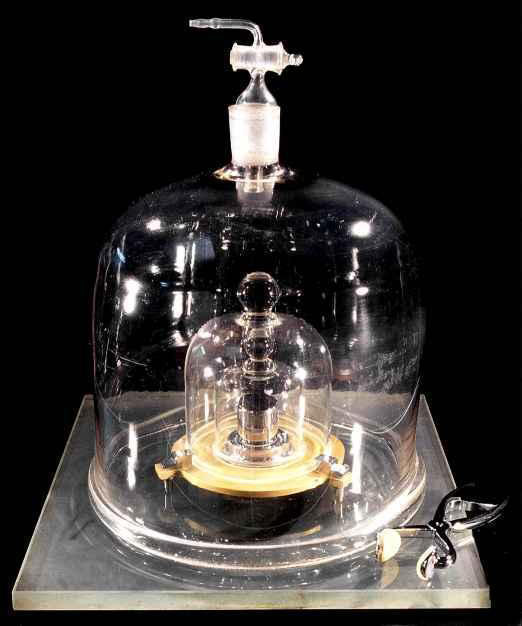
The kilogram may need to go on a diet. The international standard, a cylinder-shaped hunk of metal that defines the fundamental unit of mass, has gained tens of micrograms of mass from surface contamination, according to a new study.
As a result, each country that has one of these standard masses has a slightly different definition of the kilogram, which could throw off science experiments that require very precise weight measurements or international trade in highly restricted items that are restricted by weight, such as radioactive materials.
But ozone and ultraviolet light could be used to clean the kilograms without damaging them, the research suggests.
The cleaning technique, described in the January issue of the journal Metrologia, may eventually be widely adopted as a way to keep the fundamental unit of mass more consistent. [What's That? Your Physics Questions Answered]
In addition, since it uses "equipment that one could come by without too much investment of time and money," it is a practical technique that could be widely adopted, said Richard Davis, a metrologist who consults for the International Bureau of Weights and Measures in Paris, who was not involved in the study.
Common standard
The kilogram was first adopted as an international standard at the Convention of the Meter in 1875.At that time, scientists were frustrated that there was no consistent, standard way to measure mass with high precision.
Sign up for the Live Science daily newsletter now
Get the world’s most fascinating discoveries delivered straight to your inbox.
To solve the problem, scientists created a cylindrical hunk of mass called the international prototype kilogram (IPK) from platinum and platinum-iridium alloy. The cylinder, which weighs approximately 2.2 pounds (1 kilogram), is the definition of the kilogram. The kilogram is one of seven standard international base units of measurement.
In the 1880s, about 40 of these prototype kilograms were distributed to countries that signed the Meter Convention, said study co-author Peter Cumpson, a metrologist at Newcastle University in the U.K.
Dirty weights
Even then, scientists realized contaminants could coat the kilogram's surface. To try to counteract this effect, they made the masses into cylinders, which have less surface area to acquire dust and debris. The IPKs are stored in filtered laboratory air at constant temperature and pressure, but there's no way to completely isolate them from air pollution and contamination, Cumpson told LiveScience.
To clean them, a skilled technician will rub the cylinders with chamois leather dipped in alcohol. But because every country cleans their kilograms differently and at different times, each kilogram in the world is off by a different, unknown amount.
Cleaning the kilogram
To see how the kilogram puts on weight, Cumpson's team used an imaging technique called X-ray spectroscopy to look at surfaces similar to those of the IPKs. Those surfaces picked up tens of micrograms of carbon-based and mercury contamination a decade. And though a few dozen micrograms is not a lot, it matters for measuring things like radioactive materials, Cumpson said.
The carbon likely comes from car exhaust, while mercury contamination occurred because mercury-filled thermometers and barometers in the laboratories occasionally break.
The team also found that using ozone and ultraviolet light treatment could reliably break the bonds between carbon atoms on the surface, taking a consistent amount of carbon-based contamination away. The mercury, however, is probably there to stay, Cumpson said.
While there are other methods, "the UV ozone method is really the only one that's competitive with the manual rubbing," he said.
Fundamental constants
Long-term, however, most scientists want to get away from defining the kilogram based on a hunk of metal. Instead, it should somehow be based on a fundamental law of nature, Davis said.
"I think the definition will be changed in the next five to 10 years," Davis told LiveScience.
One possibility is using an electromagnetic device that consistently produces the same amount of force, from which the mass can then be calculated, Cumpson said.
Editor's Note: This article was updated at 12:30 p.m. Eastern Time on Jan. 7 to clarify the difference between weight and mass.
Follow LiveScience on Twitter @livescience. We're also on Facebook & Google+.

Tia is the managing editor and was previously a senior writer for Live Science. Her work has appeared in Scientific American, Wired.com and other outlets. She holds a master's degree in bioengineering from the University of Washington, a graduate certificate in science writing from UC Santa Cruz and a bachelor's degree in mechanical engineering from the University of Texas at Austin. Tia was part of a team at the Milwaukee Journal Sentinel that published the Empty Cradles series on preterm births, which won multiple awards, including the 2012 Casey Medal for Meritorious Journalism.









